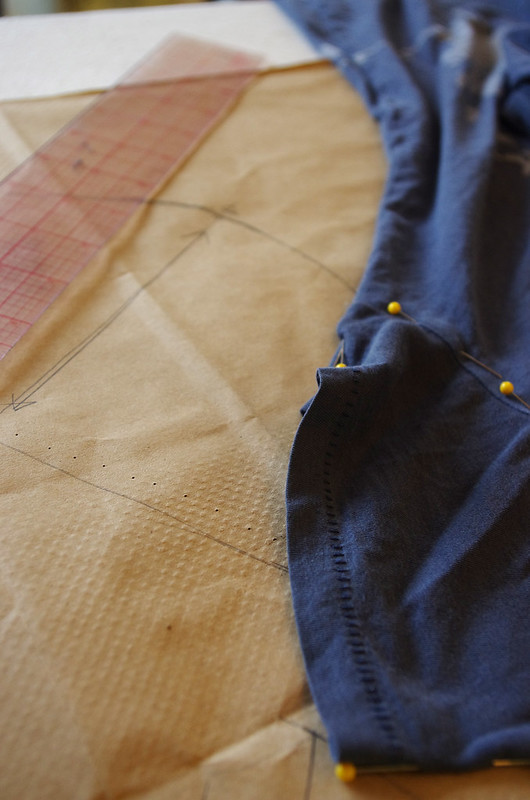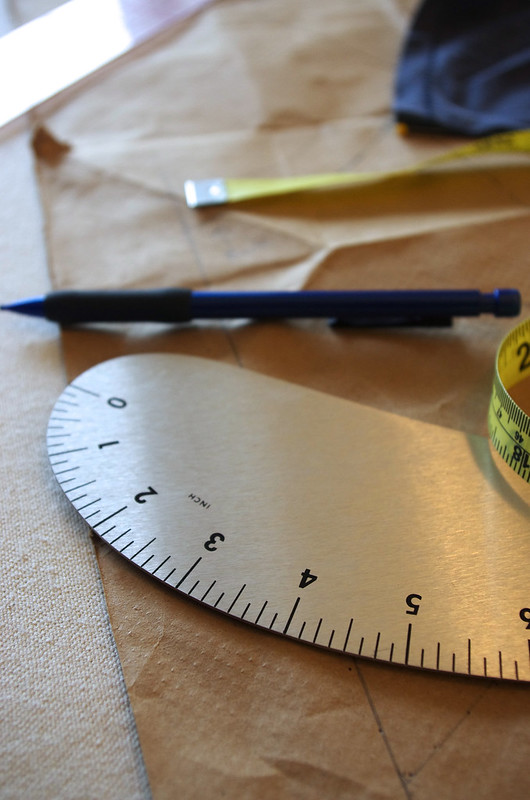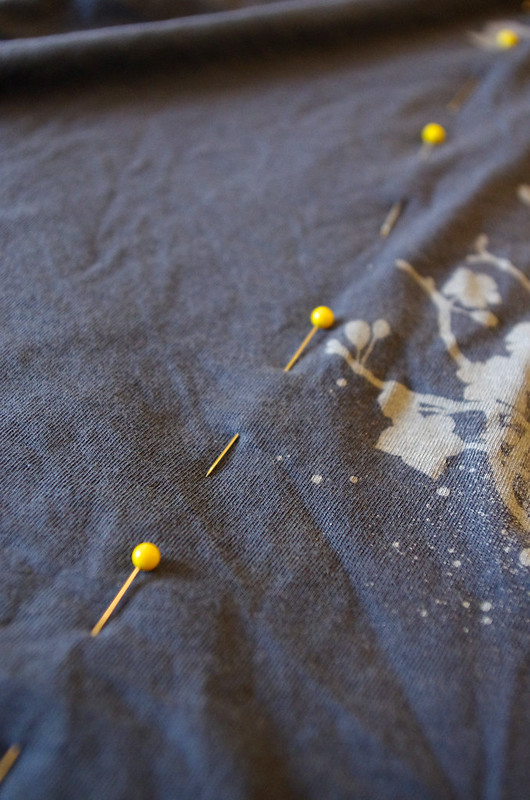This morning I was doing a bit of laundry, and as I was folding my clean shirts, I realized that my drawer of basic tees is pretty sad. I have less than a dozen t-shirts that I wear on a daily basis, and of those dozen, I probably only really like two or three of them. These are the tees that I grab whenever they're clean, and then have to wait until I do another load of laundry so I can wear them again. One of them is a shirt I bought at Powell's in Portland about five years ago, and it's looking pretty sad, but it fits so well that I can't bear to part with it.
So instead of wearing it today, I decided to garment duplicate it. So far, the Garment Duplication series has been one of the most interesting courses I've taken at NYFA. It's really taught me to look at commercially manufactured garments in a different way, both for appreciating the patternmaking and construction tricks used, and for recognizing the failings and inaccuracies of mass-market clothing.
It's also changed my thinking about the nature of originality and the ethics of copying. It might seem like cheating to duplicate a favorite garment, but if the manufacturer has changed the process or the design of that garment, or it's very old and no longer produced, it may not be possible to buy that exact one again. There's a reason we choose favorite t-shirts and sweaters in our closets, and I think it's perfectly reasonable to use those favorites as templates to design or create new things. It's always easier to start with something pretty good and change it than to start from absolute scratch - it cuts a lot of time and muslins out of the fitting process. Although I think it's disrespectful to copy an unusual or innovative design wholesale, I think garment duplicating basic items can be a very useful exercise, especially if the designer uses it as a framework to build upon rather than as an end point.
It's also changed my thinking about the nature of originality and the ethics of copying. It might seem like cheating to duplicate a favorite garment, but if the manufacturer has changed the process or the design of that garment, or it's very old and no longer produced, it may not be possible to buy that exact one again. There's a reason we choose favorite t-shirts and sweaters in our closets, and I think it's perfectly reasonable to use those favorites as templates to design or create new things. It's always easier to start with something pretty good and change it than to start from absolute scratch - it cuts a lot of time and muslins out of the fitting process. Although I think it's disrespectful to copy an unusual or innovative design wholesale, I think garment duplicating basic items can be a very useful exercise, especially if the designer uses it as a framework to build upon rather than as an end point.
So, now I'll get back to the plans for my basic tee. It's pretty typical for t-shirts to be slightly off-grain - the shirt I'm duplicating today definitely is - which isn't the biggest problem ever, but is annoying nonetheless. I'm hoping that my duplicated version will be just a notch better than the original by fixing little details like this. I'm also thinking about changing the neckline treatment to a lace edging instead of ribbing; it will dress up the garment a little bit, while keeping it washable and easy to wear.
To start with, I'm creating a pattern map for both the front and back of the garment on a cut-up paper grocery bag. (What can I say - inspiration struck and I realized I didn't have any butcher paper or sturdier craft paper, so I improvised.) I have a feeling that I'll have to tweak the pattern once or twice after the initial draft, but I already know that the body fits me really well, so it's likely that the sleeves will cause the most trouble. I have some warm yellow rayon/lycra jersey in my stash, so I'll probably use that to start with, then move on to a gorgeous nautical-stripe bamboo blend once I get the pattern perfected.




2 comments:
I am curious about your take on the difference between copying and using the pattern for inspiration. What defines copying and what defines inspiration? Is it percentage of traits that are carried over to the new garment? Is it materials and embellishes that are put on it? Is it the core elements of the design?
Good questions! This subject is always a bit tricky, and definitely depends on the garment type and the intent of the designer. If I were straight-up duplicating the fit and graphic print of this tee and turning around to sell it off for $40 a t-shirt, it would definitely be copying, and that would be a problem. But just to turn the tables, I also think that if someone went to the trouble to design a simple jacket straight out of the Balenciaga archives, used similar style lines and colors but did all the patternwork, changed the proportions to fit their body, and tailored and fitted the garment perfectly, I would see it as Balenciaga-inspired (and super impressive).
For me, I do think that although what I'm doing is technically copying at the outset, I'm doing a significant amount of work and modification to the garment that puts it more in a grey area between copying and design: I'm doing the patternwork myself, modifying the pattern based on the fit of the muslin, and changing the materials and some of the seam treatments. It's difficult to put any hard and fast rules on what percentage of the garment you have to change to make it original, particularly because a t-shirt is so basic. It's a back, front, two sleeves, and some sort of seam treatment at the neck, arms, and hem. All of those elements have to be there to have a functional garment, and there's only so many ways each of them can be done, so the originality of the design is necessarily going to be limited. For me specifically, this pattern is merely the first draft in my quest for the perfectly fitted, casual-but-can-be-dressed-up tee. The first draft will be a copy, but from there, who knows.
So, on a related note - although copyright extends over a lot of creative intellectual property, it doesn't cover clothing, which keeps any one person from gaming the system by, say, copyrighting a t-shirt as a concept and then charging ridiculous licensing fees to use it. There are certain things in fashion that have been around forever and should never be strictly the property of one person: pleats, a-line skirts, sailor collars, cropped tees - all of these things, although sometimes indicative of a certain era because of a time and place they came into fashion, are a standard part of the fashion lexicon, and their use not only cannot but should not be restricted. It's definitely a very different framework to work within than other media, and at times it feels more free in a good way, while at others, is frustratingly inadequate at protecting truly original work.
The short answer is: it's really hard to define. I think as long as a designer is using a copy to push themselves to create something new or learn something about their craft, it's safe territory. Now, turning around and commercializing an exact copy is a different story, but in general, I think that copying is valuable fodder for creativity and can be treated as a type of inspiration in its own right.
Thanks for your comment, and I hope that my very long-winded response answered your questions! <3
Post a Comment